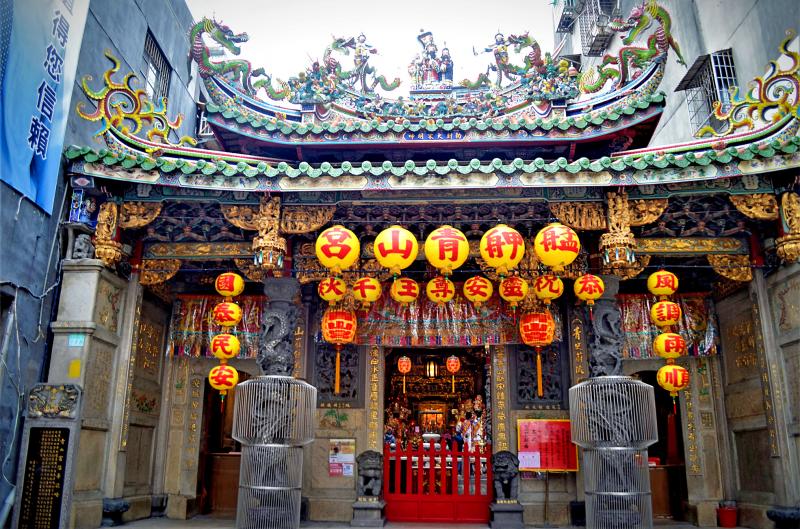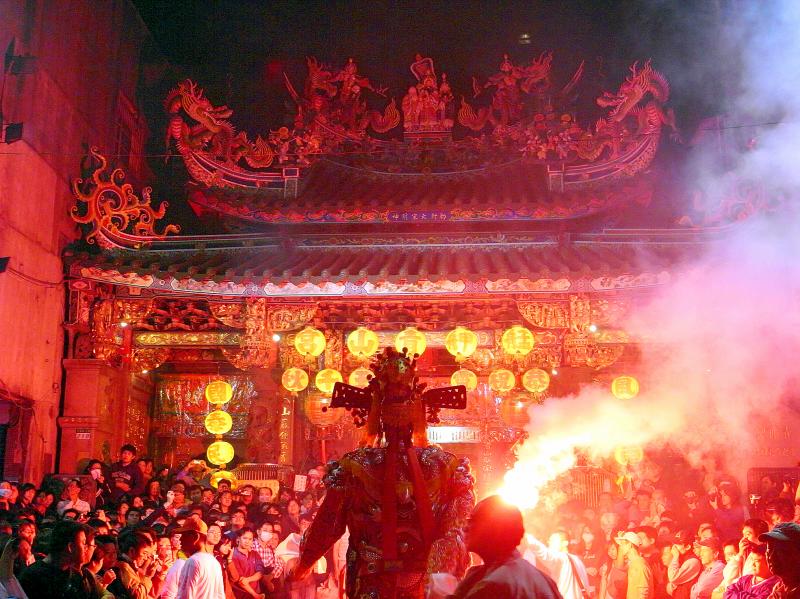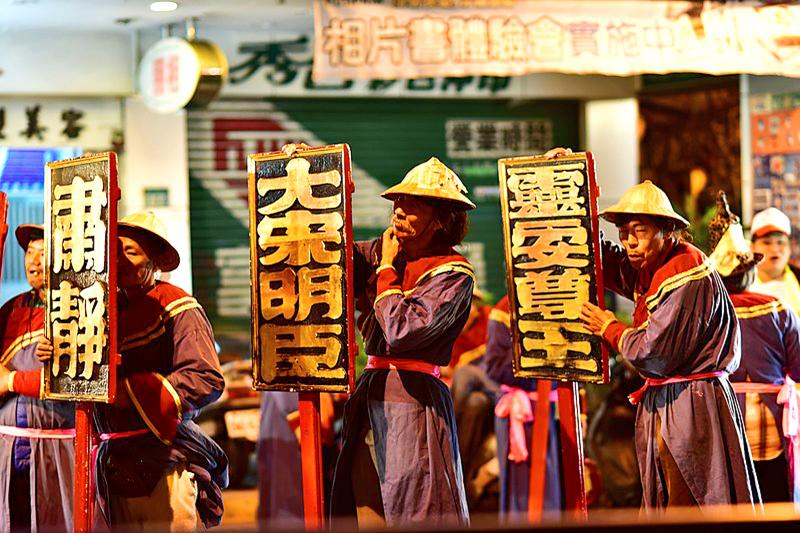Dec. 14 to Dec. 20
A group of fishermen set sail from Taiwan in 1854 to protect today’s Wanhua District (萬華) from a devastating pandemic by retrieving a deity, known as Qingshanwang (青山王, Green Mountain King), from their ancestral home of Huian County (惠安) in Quanzhou City, Fujian Province. Upon returning to Wanhua, they hauled it inland, but only made it a little way because the effigy suddenly became too heavy to move. Worshippers saw it as a sign and built the first iteration of Qingshan Temple (青山宮).
Due to Qingshanwang’s reputation for warding off diseases, Qingshan Temple became too crowded, so officials built a larger structure nearby in 1856. Qing-era Taipei was prone to epidemics due to its poor sanitary conditions, and the temple became the main source of solace for the people in times of sickness.

Photo courtesy of Wikimedia Commons
A rat plague in 1904 allegedly abated after a rat corpse was found in Qingshanwang’s sleeve, further cementing the local belief in the temple’s miraculous powers.
Qingshan Temple celebrated its patron deity’s birthday this past weekend with reportedly its biggest procession in the past 50 years — but it is now under fire after countless residents complained about the noise from loudspeakers and firecrackers that continued through the night.
GROWING IN SIZE

Photo courtesy of Wikimedia Commons
The temple in Wanhua wasn’t the first of its kind dedicated to the deity in Taiwan. Settlers also from Huian County founded the Lingshan Temple (靈山宮) in Changhua as early as 1800.
There are two main theories for the deity’s origins. Some say that he was originally Chang Kun (張悃), a revered 10th century general of the Min Kingdom, while other sources maintain that he was a different Chang Kun (張梱), who served the Kingdom of Wu about 700 years earlier. Both Min and Wu’s territory encompassed Huian County. Today, Qingshan Temple officially embraces the latter hypothesis.
The Japanese colonial government allowed the temple’s festivities to continue, and the event grew in size every year according to reports between 1907 and 1909. A 1914 report claims that its scale was comparable to that of Dadaocheng’s (大稻埕) Xia Hai City God Temple (霞海城隍廟), located several kilometers to the north.

Photo courtesy of Wikimedia Commons
The 1935 event was the grandest during the Japanese era, as it coincided with the extravagant and ambitious Taiwan Exhibition held to celebrate 40 years of colonial rule. Exhibition organizers planned to have Beigang’s (北港) Chaotian Temple (朝天宮) hold its famed Matsu procession in Taipei, and eventually they decided to combine it with the Qingshan Temple’s event. It also happened to be a Sunday, and Matsu temples from across Taiwan joined in the festivities, with nearly 10,000 people marching throughout Taipei. It was also noted that the procession reached as far as the governor-general’s office (today’s Presidential Office) for the first time.
This was the temple’s last hurrah for the time being, as Japan soon launched its kominka policy to assimilate all Taiwanese, and all temple festivals were banned.
AUSTERITY MEASURES
As soon as the Japanese surrendered in August 1945, Qingshan Temple started planning to revive its procession. It paled in scale to the 1935 affair, but still attracted crowds of worshippers.
People began hosting massive banquets during the festivities in the 1950s. In 1951, the United Daily News (聯合報) reported that at least 500 pigs and 10,000 ducks were slaughtered just in Wanhua for the occasion, even when vendors raised their prices by about 10 percent.
A 1958 report noted that in addition to the locals, about 20,000 guests traveled to the area to partake in the banquets. The article noted that the estimated amount of money spent on food was enough to build another Zhongxing Bridge (中興橋), which was completed a month before the procession and connected Wanhua with Sanchong (三重) opposite the Tamsui River.
In the 1960s, media reports started focusing more on the negative aspects of the festivities — drunken brawls, children getting separated from their parents, people passed out on the street. The government also launched its austerity campaign to stamp out wasteful behavior. The procession route was cut by two-thirds in 1967, and in 1970 the temple decided not to have a parade nor a banquet to demonstrate compliance with the government’s frugality campaign.
As part of these measures, festivities for each deity were limited to one day per year, which suggested that the “night processions” that were held for two nights before the major parade were canceled.
By the 1980s, the feasts of the 1950s were no more.
“Although the festivities of the past were indeed excessive, they are now unforgettable memories for longtime Wanhua residents and those who partook in the banquets,” the United Daily News reported in 1988.
RESURGENCE
With the lifting of martial law in 1987 and improvement in people’s living standards, however, the 1989 event returned with a vengeance and was reported to be bigger than ever. The night procession, which the city now lists as intangible cultural heritage events, were also revived that year.
In 1990, the Taipei City Government started actively supporting these temple festivals, hoping to transform them into tourist attractions and cultural events. At the same time, politicians and candidates for public office began making appearances at Qingshan Temple’s festivities to garner support, a tradition that continues.
In 2000, the city government and the temple launched the first Tshing Shan Festival “Cultural Carnival (民俗嘉年華會),” and that year’s procession was reported to be the largest since the 1989 event.
Qingshan Temple also took ownership of its role in warding off diseases during the SARS pandemic in 2003, organizing a three-day blessing ceremony with more than 30 temples participating and holding a massive procession that concluded with the burning of a King Boat (王船).
During the height of the COVID-19 pandemic earlier this year, however, it was just one of 206 temples participating in a blessing ceremony that was livestreamed due to social distancing protocols.
However, as Wanhua’s population shifts and people become less attuned to religious activities, the noise complaints have also grown over the years.
An interviewee for the 2011 paper Folk Celebrations and Collective Memories — Wanhua’s Qingshan Temple as a Case Study (民俗活動與集體記憶 — 以艋胛青山宮為例) by Chen Ya-fang (陳雅芳) mentions that residents who were not interested in temple festivals were becoming increasingly annoyed with the firecracker noise, and another noted that the temple was fined in 2009 due to resident complaints.
The issue received widespread media attention in 2011, as that year’s celebration was also a larger-than-usual affair for the 100th anniversary of the Republic of China (ROC). The firecrackers went on until 3am for three days straight — and residents couldn’t stand it anymore, launching a petition for the temple to ameliorate the situation.
Unfortunately, this year’s event was even worse as the noise didn’t die down until dawn. The temple apologized and vowed to do better next year, and this struggle between tradition and modernity continues.
Taiwan in Time, a column about Taiwan’s history that is published every Sunday, spotlights important or interesting events around the nation that either have anniversaries this week or are tied to current events.

On a hillside overlooking Taichung are the remains of a village that never was. Half-formed houses abandoned by investors are slowly succumbing to the elements. Empty, save for the occasional explorer. Taiwan is full of these places. Factories, malls, hospitals, amusement parks, breweries, housing — all facing an unplanned but inevitable obsolescence. Urbex, short for urban exploration, is the practice of exploring and often photographing abandoned and derelict buildings. Many urban explorers choose not to disclose the locations of the sites, as a way of preserving the structures and preventing vandalism or looting. For artist and professor at NTNU and Taipei

March 10 to March 16 Although it failed to become popular, March of the Black Cats (烏貓進行曲) was the first Taiwanese record to have “pop song” printed on the label. Released in March 1929 under Eagle Records, a subsidiary of the Japanese-owned Columbia Records, the Hoklo (commonly known as Taiwanese) lyrics followed the traditional seven characters per verse of Taiwanese opera, but the instrumentation was Western, performed by Eagle’s in-house orchestra. The singer was entertainer Chiu-chan (秋蟾). In fact, a cover of a Xiamen folk song by Chiu-chan released around the same time, Plum Widow Missing Her Husband (雪梅思君), enjoyed more

Last week Elbridge Colby, US President Donald Trump’s nominee for under secretary of defense for policy, a key advisory position, said in his Senate confirmation hearing that Taiwan defense spending should be 10 percent of GDP “at least something in that ballpark, really focused on their defense.” He added: “So we need to properly incentivize them.” Much commentary focused on the 10 percent figure, and rightly so. Colby is not wrong in one respect — Taiwan does need to spend more. But the steady escalation in the proportion of GDP from 3 percent to 5 percent to 10 percent that advocates

From insomniacs to party-goers, doting couples, tired paramedics and Johannesburg’s golden youth, The Pantry, a petrol station doubling as a gourmet deli, has become unmissable on the nightlife scene of South Africa’s biggest city. Open 24 hours a day, the establishment which opened three years ago is a haven for revelers looking for a midnight snack to sober up after the bars and nightclubs close at 2am or 5am. “Believe me, we see it all here,” sighs a cashier. Before the curtains open on Johannesburg’s infamous party scene, the evening gets off to a gentle start. On a Friday at around 6pm,